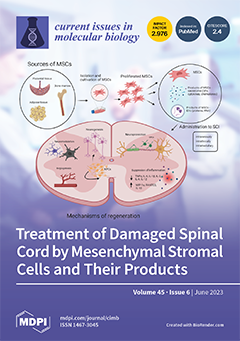
Journal Menu
► ▼ Journal MenuJournal Browser
► ▼ Journal Browser-
arrow_forward_ios
Forthcoming issue
arrow_forward_ios Current issue - Volumes not published by MDPI
- Vol. 42 (2021)
- Vol. 41 (2021)
- Vol. 40 (2021)
- Vol. 39 (2020)
- Vol. 38 (2020)
- Vol. 37 (2020)
- Vol. 36 (2020)
- Vol. 35 (2020)
- Vol. 34 (2019)
- Vol. 33 (2019)
- Vol. 32 (2019)
- Vol. 31 (2019)
- Vol. 30 (2019)
- Vol. 29 (2018)
- Vol. 28 (2018)
- Vol. 27 (2018)
- Vol. 26 (2018)
- Vol. 25 (2018)
- Vol. 24 (2017)
- Vol. 23 (2017)
- Vol. 22 (2017)
- Vol. 21 (2017)
- Vol. 20 (2016)
- Vol. 19 (2016)
- Vol. 18 (2016)
- Vol. 17 (2015)
- Vol. 16 (2014)
- Vol. 15 (2013)
- Vol. 14 (2012)
- Vol. 13 (2011)
- Vol. 12 (2010)
- Vol. 11 (2009)
- Vol. 10 (2008)
- Vol. 9 (2007)
- Vol. 8 (2006)
- Vol. 7 (2005)
- Vol. 6 (2004)
- Vol. 5 (2003)
- Vol. 4 (2002)
- Vol. 3 (2001)
- Vol. 2 (2000)
- Vol. 1 (1999)
Need Help?
Curr. Issues Mol. Biol., Volume 45, Issue 6 (June 2023) – 46 articles
Cover Story (view full-size image):
Damage to the spinal cord is a devastating process that leads to the failure of motor, sensory and autonomic functions and for which, unfortunately, there is currently no effective treatment. One of the most promising approaches in the treatment of spinal cord injury is cell therapy. Mesenchymal stromal cells (MSCs) stand out amongst a large number of investigated cells. MSCs participate in the regeneration of damaged tissue in two main ways, directly with their ability to differentiate, so they can replace damaged cells in the tissue, or indirectly using the paracrine effect. In this case, MSCs serve as a source of bioactive molecules and growth factors, as well as extracellular vesicles, so they exhibit their immunomodulating, angiogenic, and neuroprotective effects at the site of injury. View this paper
- Issues are regarded as officially published after their release is announced to the table of contents alert mailing list.
- You may sign up for e-mail alerts to receive table of contents of newly released issues.
- PDF is the official format for papers published in both, html and pdf forms. To view the papers in pdf format, click on the "PDF Full-text" link, and use the free Adobe Reader to open them.
Previous Issue
Next Issue
Issue View Metrics
Multiple requests from the same IP address are counted as one view.





